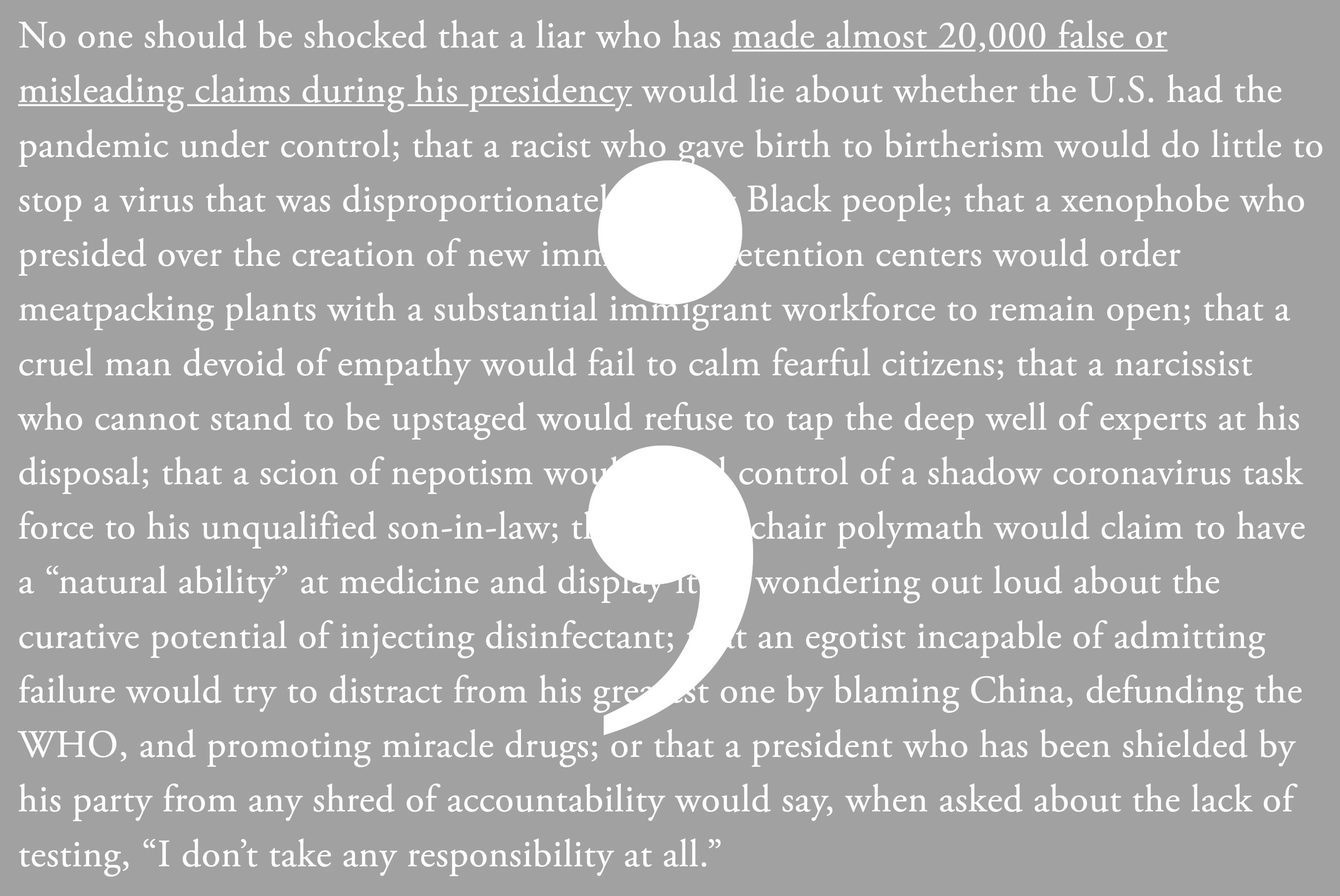
Make that the semicolon! It’s a maligned mark in the journalism world but it enabled the Atlantic reporter to build a breathtaking 212-word sentence.
Surely the most maligned mark of punctuation among journalists is the semicolon. They fear it, avoid it, doubt their ability to use it correctly. It seems stodgy, archaic and academic, traits they are determined to avoid. Instead they use the dash — promiscuously.
But the semicolon has its fans. I am one of them. I devote a chapter to it in my book “The Glamour of Grammar,” where I offer the metaphor of the “swinging gate”: “That’s how I see the semicolon in my own writing, as a gate that stands between two thoughts, a barrier that forces separation but invites you to pass through to the other side.”
(I thought a chapter on the semicolon was ambitious until I ran into Cecelia Watson’s book “Semicolon: The Past, Present, and Future of a Misunderstood Mark.”)
To appreciate the semicolon, we need to see it in action. This morning my Poynter colleague Tom Jones called attention to the work of one journalist covering the story of the coronavirus who has “stood out above all.” He writes: “The Atlantic’s Ed Yong has been a rock star — an absolute must-read throughout this pandemic. And his latest story for The Atlantic is nothing short of elite. His richly-reported analysis — “How the Pandemic Defeated America” — elicits every negative emotion, from sadness to frustration to helplessness to outright seeing-red anger.”
Jones highlights one paragraph for our close attention:
No one should be shocked that a liar who has made almost 20,000 false or misleading claims during his presidency would lie about whether the U.S. had the pandemic under control; that a racist who gave birth to birtherism would do little to stop a virus that was disproportionately killing Black people; that a xenophobe who presided over the creation of new immigrant-detention centers would order meatpacking plants with a substantial immigrant workforce to remain open; that a cruel man devoid of empathy would fail to calm fearful citizens; that a narcissist who cannot stand to be upstaged would refuse to tap the deep well of experts at his disposal; that a scion of nepotism would hand control of a shadow coronavirus task force to his unqualified son-in-law; that an armchair polymath would claim to have a ‘natural ability’ at medicine and display it by wondering out loud about the curative potential of injecting disinfectant; that an egotist incapable of admitting failure would try to distract from his greatest one by blaming China, defunding the WHO, and promoting miracle drugs; or that a president who has been shielded by his party from any shred of accountability would say, when asked about the lack of testing, “I don’t take any responsibility at all.”
Jones describes this as a paragraph, which it is; but, more remarkable, it’s a sentence, a single sentence of 212 words. No journalism text I know of will recommend such a length. But Yong makes it work with a little help from his language friends. They are: placement of subject and verb; the word “that” used as a conjunction; and, of course, the semicolon. Not just one semicolon, mind you, but eight. In one sentence.
I have written a book titled “How to Write Short,” but in another book, “Writing Tools,” I offer appreciation for the well-organized long sentence. One of the secrets to crafting such a sentence is to make sure that the subject and verb of the main clause come early. If meaning is created in the first few words, the writer is free to stretch out with examples. Yong sets the stage with five one-syllable words: “No one should be shocked …”
What follows is one of most useful and under-appreciated words in the English language: “that.” That word appears nine times in the sentence. It begins the litany of subordinate clauses. It marks the drumbeat of parallel constructions. And because it is just “that,” it is hardly visible at all.
Because you can barely see it, “that” lacks the power to hold the big pieces together. A cathedral sentence such as this one requires the equivalent of flying buttresses to support its weight. The framework that separates the parts, but also holds them together, is created by our modest friend the semicolon.
If Yong has written the sentence of the year, and I believe he has, he can thank the semicolon; we all can.
Roy Peter Clark teaches writing at Poynter. He can be reached via email at roypc@poynter.org or on Twitter at @RoyPeterClark.
"avoid it" - Google News
August 04, 2020 at 09:38PM
https://ift.tt/2Prwe7i
What helped Ed Yong write the sentence of the year? – Poynter - Poynter
"avoid it" - Google News
https://ift.tt/3844a1y
https://ift.tt/2SzWv5y

No comments:
Post a Comment